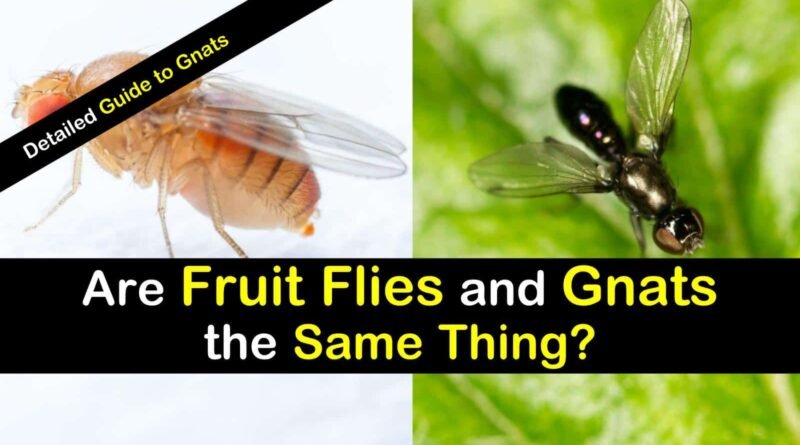Fruit Flies vs Gnats: Understanding the Differences and How to Manage Them
Introduction
In the realm of tiny flying insects that often invade our homes, fruit flies and gnats are two of the most common culprits. Though they may seem similar at first glance, these pests differ in their behavior, biology, and management strategies. Understanding these differences is crucial for effective control and prevention. In this article, we’ll delve into the key distinctions between fruit flies and gnats, explore their respective habits, and offer practical tips for managing and preventing infestations.
Identifying Fruit Flies and Gnats
Fruit Flies (Drosophila melanogaster)
Fruit flies are small, usually about 1/8 inch long, and are characterized by their tan or light brown bodies with distinctive red eyes. They have a rapid life cycle, which contributes to their frequent appearances in homes, particularly around food sources. Fruit flies are often attracted to ripened, fermenting, or decaying fruits and vegetables. They are also drawn to sugary substances and residues, making them common in kitchens, garbage disposals, and even in the bottom of soda cans.
Gnats
Gnats is a broad term that encompasses several different species, but the two most common types encountered in homes are fungus gnats and drain flies.
- Fungus Gnats: These are small, usually black or gray, with delicate wings and long legs. They are often found in soil that is kept overly moist. Fungus gnats are notorious for their larvae, which feed on organic matter in the soil and can damage plant roots.
- Drain Flies (also known as Sewer Flies): Drain flies are slightly larger, with fuzzy, moth-like wings and a gray or black body. They are typically found near drains, garbage disposals, and other moist, organic-rich environments. Unlike fruit flies, drain flies are more likely to be found around stagnant water and decomposing organic material in drains.
Behavior and Habits
Fruit Flies
Fruit flies are highly attracted to fermentation. This means they are frequently seen around fruit bowls, compost bins, and garbage cans. Their rapid reproduction rate—females can lay up to 500 eggs in a single batch—can lead to large infestations in a short period. They are most active in warmer weather but can be found indoors year-round.
Gnats
- Fungus Gnats: They thrive in moist environments, particularly where there is decomposing organic matter. Indoor plant soil is a common breeding ground. These gnats are often seen fluttering around houseplants and can be an indication of overwatering or poor soil drainage.
- Drain Flies: As their name suggests, drain flies are most commonly found around drains. They breed in the organic sludge that accumulates in pipes. They are particularly active in warm, damp conditions, and can become a problem in bathrooms and kitchens where hygiene is lacking.
Prevention and Control Strategies
Preventing and Managing Fruit Flies
- Cleanliness: Regularly clean surfaces, especially where food is prepared and consumed. Pay attention to crumbs and spills. Fruit flies are attracted to residues that may not be immediately visible.
- Proper Food Storage: Store fruits and vegetables in the refrigerator or in sealed containers. Dispose of overripe or decaying produce promptly.
- Waste Management: Keep garbage bins clean and use sealed bags. Take out the trash regularly and clean bins to remove residues.
- DIY Traps: You can make simple traps using apple cider vinegar or wine. Fill a small bowl with vinegar or wine, cover it with plastic wrap, and poke small holes in the wrap. The fruit flies will be attracted to the liquid, enter through the holes, and become trapped.
- Professional Help: In severe cases, professional pest control may be necessary to address infestations and locate breeding sites that are difficult to reach.
Preventing and Managing Gnats
- Fungus Gnats:
- Watering Practices: Allow the top layer of soil to dry out between waterings. Overwatering creates the ideal environment for gnat larvae.
- Soil Care: Use well-draining soil and avoid letting pots sit in excess water. Consider using sand or diatomaceous earth on the surface of the soil to deter gnats.
- Plant Health: Inspect plants regularly and remove any infested or dying plant material that may harbor gnats.
- Drain Flies:
- Clean Drains: Regularly clean drains with a mixture of baking soda and vinegar or use commercial drain cleaners to remove organic material.
- Repair Leaks: Fix any plumbing issues that lead to standing water and ensure drains are properly sealed.
- Maintain Hygiene: Keep areas around drains dry and clean. Regular cleaning of the kitchen and bathroom areas helps prevent the buildup of organic matter.
Conclusion
While fruit flies and gnats may both be small, their differences in behavior and breeding habits necessitate distinct approaches to control and prevention. Fruit flies are typically associated with food and fermenting substances, making kitchen cleanliness and proper food storage key strategies in managing them. Gnats, including fungus gnats and drain flies, are more linked to moisture and organic matter in soil or drains, requiring targeted measures such as adjusting watering habits and maintaining clean drainage systems.
By understanding the specific characteristics and habits of these pests, homeowners can implement more effective management strategies and reduce the likelihood of infestations. Keeping a clean environment and addressing potential breeding grounds are crucial steps in maintaining a pest-free home.
